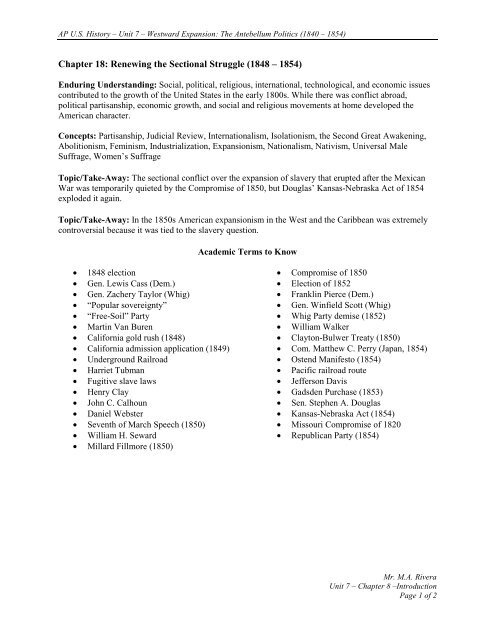Chapter 18: Renewing the Sectional Struggle (1848 – 1854)
Chapter 18: Renewing the Sectional Struggle (1848 – 1854)
Chapter 18: Renewing the Sectional Struggle (1848 – 1854)
Create successful ePaper yourself
Turn your PDF publications into a flip-book with our unique Google optimized e-Paper software.
AP U.S. History <strong>–</strong> Unit 7 <strong>–</strong> Westward Expansion: The Antebellum Politics (<strong>18</strong>40 <strong>–</strong> <strong>18</strong>54)<br />
<strong>Chapter</strong> <strong>18</strong>: <strong>Renewing</strong> <strong>the</strong> <strong>Sectional</strong> <strong>Struggle</strong> (<strong>18</strong>48 <strong>–</strong> <strong>18</strong>54)<br />
Enduring Understanding: Social, political, religious, international, technological, and economic issues<br />
contributed to <strong>the</strong> growth of <strong>the</strong> United States in <strong>the</strong> early <strong>18</strong>00s. While <strong>the</strong>re was conflict abroad,<br />
political partisanship, economic growth, and social and religious movements at home developed <strong>the</strong><br />
American character.<br />
Concepts: Partisanship, Judicial Review, Internationalism, Isolationism, <strong>the</strong> Second Great Awakening,<br />
Abolitionism, Feminism, Industrialization, Expansionism, Nationalism, Nativism, Universal Male<br />
Suffrage, Women’s Suffrage<br />
Topic/Take-Away: The sectional conflict over <strong>the</strong> expansion of slavery that erupted after <strong>the</strong> Mexican<br />
War was temporarily quieted by <strong>the</strong> Compromise of <strong>18</strong>50, but Douglas’ Kansas-Nebraska Act of <strong>18</strong>54<br />
exploded it again.<br />
Topic/Take-Away: In <strong>the</strong> <strong>18</strong>50s American expansionism in <strong>the</strong> West and <strong>the</strong> Caribbean was extremely<br />
controversial because it was tied to <strong>the</strong> slavery question.<br />
• <strong>18</strong>48 election<br />
• Gen. Lewis Cass (Dem.)<br />
• Gen. Zachery Taylor (Whig)<br />
• “Popular sovereignty”<br />
• “Free-Soil” Party<br />
• Martin Van Buren<br />
• California gold rush (<strong>18</strong>48)<br />
• California admission application (<strong>18</strong>49)<br />
• Underground Railroad<br />
• Harriet Tubman<br />
• Fugitive slave laws<br />
• Henry Clay<br />
• John C. Calhoun<br />
• Daniel Webster<br />
• Seventh of March Speech (<strong>18</strong>50)<br />
• William H. Seward<br />
• Millard Fillmore (<strong>18</strong>50)<br />
Academic Terms to Know<br />
• Compromise of <strong>18</strong>50<br />
• Election of <strong>18</strong>52<br />
• Franklin Pierce (Dem.)<br />
• Gen. Winfield Scott (Whig)<br />
• Whig Party demise (<strong>18</strong>52)<br />
• William Walker<br />
• Clayton-Bulwer Treaty (<strong>18</strong>50)<br />
• Com. Mat<strong>the</strong>w C. Perry (Japan, <strong>18</strong>54)<br />
• Ostend Manifesto (<strong>18</strong>54)<br />
• Pacific railroad route<br />
• Jefferson Davis<br />
• Gadsden Purchase (<strong>18</strong>53)<br />
• Sen. Stephen A. Douglas<br />
• Kansas-Nebraska Act (<strong>18</strong>54)<br />
• Missouri Compromise of <strong>18</strong>20<br />
• Republican Party (<strong>18</strong>54)<br />
Mr. M.A. Rivera<br />
Unit 7 <strong>–</strong> <strong>Chapter</strong> 8 <strong>–</strong>Introduction<br />
Page 1 of 2
AP U.S. History <strong>–</strong> Unit 7 <strong>–</strong> Westward Expansion: The Antebellum Politics (<strong>18</strong>40 <strong>–</strong> <strong>18</strong>54)<br />
Guided Reading Questions<br />
1. Who were <strong>the</strong> three nominees for president of <strong>the</strong> U.S. in <strong>the</strong> election of <strong>18</strong>48, what parties did <strong>the</strong>y<br />
represent, and what were <strong>the</strong>ir ideas regarding slavery?<br />
2. What factor led to <strong>the</strong> increase in population in California, how did California apply for free statehood,<br />
and how did California’s application threaten <strong>the</strong> balance of power in <strong>the</strong> Senate?<br />
3. What was <strong>the</strong> Underground Railroad, who was Harriet Tubman, and how many slaves did she free en<br />
route to Canada?<br />
4. Who were <strong>the</strong> “Three Giants” who met to discuss a compromise to <strong>the</strong> slavery issue and why were two<br />
of <strong>the</strong> three seen as traitors to <strong>the</strong>ir region? How were <strong>the</strong>se compromises eventually signed into law by<br />
Millard Fillmore in what became known as <strong>the</strong> Compromise of <strong>18</strong>50?<br />
5. What were <strong>the</strong> details of <strong>the</strong> Compromise of <strong>18</strong>50 and what did each of <strong>the</strong> regions (north and south)<br />
get?<br />
6. How did <strong>the</strong> election of <strong>18</strong>52 end <strong>the</strong> Whig party?<br />
7. How did Williams Walker and <strong>the</strong> Ostend Manifesto contribute to people’s <strong>the</strong>ories about <strong>the</strong><br />
“slavocracy” in <strong>the</strong> South?<br />
8. How did <strong>the</strong> U.S. enter into negotiations for opening up <strong>the</strong> East for trade with China and Japan?<br />
9. Why was it determined that <strong>the</strong>re was a need for a transcontinental railroad, what two factors<br />
contributed to <strong>the</strong> Gadsden Purchase and how much was paid for it?<br />
10. What were <strong>the</strong> stipulations of <strong>the</strong> Kansas-Nebraska Act, how did it repeal <strong>the</strong> Missouri Compromise,<br />
why were nor<strong>the</strong>rners against it, and how did it wreck <strong>the</strong> Compromise of <strong>18</strong>50, <strong>the</strong> Fugitive Slave Law,<br />
and <strong>the</strong> Democratic Party?<br />
Mr. M.A. Rivera<br />
Unit 7 <strong>–</strong> <strong>Chapter</strong> 8 <strong>–</strong>Introduction<br />
Page 2 of 2





